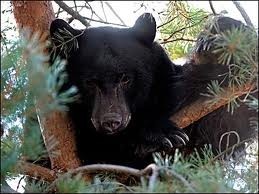ATLANTA - Black bears like the one that rambled through backyards in Atlanta's northern suburbs in August could soon be permanent residents in north Fulton, Gwinnett and Cherokee counties, having cubs and multiplying, wildlife biologists say.
The animals could be reproducing well inside the Atlanta metro area within the next decade, which would mean a new way of life for suburban residents not accustomed to living in bear country, experts say.
North Georgia's bear population, which extends south from the mountains into areas near Cumming, appears to be growing and the animals are competing for territory, said Don McGowan, a wildlife biologist with the Georgia Department of Natural Resources.
"It's going to result in an expansion of their geographic range and we may be seeing that already," McGowan said.
In late August, residents at the Country Club of the South in the Atlanta suburb of Johns Creek called police to report seeing a bear. A few days earlier, a bear was seen in Sandy Springs and in the Dunwoody area just north of Atlanta. Police suspect it was the same animal.
Trends suggest that bears could be permanently established in parts of north Fulton, Cherokee and northern Gwinnett counties within the next 10 years, he said.
Researchers say bears are expanding their range nationwide, and are being seen in metro areas such as Birmingham, Ala., and Tulsa, Okla.
"Overall, bears are expanding pretty much everywhere," said Eric Hellgren, director of the Cooperative Wildlife Research Laboratory at Southern Illinois University-Carbondale.
"In most states they're either stable or they're increasing," he said. "And if they're increasing, that generally means they're going to start coming into contact with people more often and that's certainly a nationwide issue."
In north Alabama, wildlife officials say black bears have been showing up more often in recent years. Police spent much of one night in June chasing a bear through neighborhoods near downtown Birmingham - the state's largest city - before finally shooting it with a tranquilizer gun.
In Missouri, state officials in June announced the start of a two-year effort to determine how many black bears are living in the state after an increase in sightings.
Hellgren said the U.S. bear population has boomed as hunting declined. Though hunting black bears is still legal in many places "the hunting hasn't been adequate to drive the population down."
The total U.S. bear population more than doubled between 1989 and 2006, rising from 165,000 to over 350,000, the nonprofit International Association of Bear Research and Management found when it studied the issue.
Estimating the number of bears is specific areas is difficult, Hellgren said. But it's clear that they've thrived in much of the South, including the Blue Ridge Mountains and in the Ozarks. In the late 1950s and 1960s, about 250 bears were transported from Minnesota and Canada to Arkansas, where the population grew to more than 3,000 today.
As bears move into urban areas, Hellgren said residents will have to adapt and perhaps change the way they store garbage and where they place bird feeders.
"They'll eat corn, they'll eat peanuts, they'll eat bird food," he said.
Researchers using radio collars to track bears in the Upper Midwest have found that some bears are now living on farmlands, said Dave Garshelis, a bear research scientist with the Minnesota Department of Natural Resources.
"You picture a black bear as an animal that lives primarily in the forest but we have bears now that live in places with less than 20 percent forest," Garshelis said. "In the fall, they eat from the farmers' crops and that's becoming widespread."
More bears are also passing through the Twin Cities area than 10 or 15 years ago, he said.
In metro Atlanta, homes and businesses might have to use bear-proof trash receptacles like the ones already in place in the Chattahoochee River National Recreation Area in Johns Creek and elsewhere in the federal park.
The booming population of metro Atlanta's northern suburbs might entice black bears to become neighbors. The animals are highly adaptable, "so a high population center like the metro area is not necessarily a deterrent to bears expanding," McGowan said.
"In fact, it may be conducive in some respects because of food sources," he said. "They may live a pretty good life in these areas if they can dodge all the cars."
Tuesday
July 8th, 2025
5:40PM









